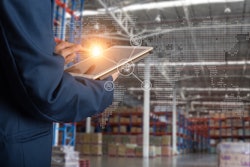
As supply chain problems persist into a third calendar year, the industry faces numerous challenges, not the least of which includes climbing expectations around customer experience. All eyes are on the supply chain, but the influx of media coverage focused on the industry’s challenges has in some ways been a boon. Consumers and merchants who previously had no insight into the delivery process have a greater understanding of its roadblocks. Still, feelings of frustration prevail, especially when it comes to the delivery of heavy goods like furniture.
Focus on supply chain issues has spurred a newfound interest in the industry. Claims that “the worst is over” swirl alongside assertions that the ongoing surges and waves of the pandemic will continue to create volatility. For delivery companies, what worked yesterday no longer guarantees success and adaptability is key to keeping pace with customer demand.
The delivery experience
Deliveries will continue to face delays, especially when it comes to heavy and bulky goods (items that weigh more than 150 pounds, require assembly or installation, or have unusual dimensions), and there’s little that logistics professionals can do about certain problems plaguing the supply chain (container ships waiting to be unloaded at ports, for example). There are ways of improving the delivery experience, however. As consumers continue to shy away from in-person purchasing due to the pandemic and gravitate instead towards the convenience of e-commerce, new infrastructure is emerging to facilitate remote and ‘click and mortar’ purchasing options for heavy goods. The need for digital transformation in this historically analog industry is increasingly acute, with a specific focus on digitizing the final-mile delivery process for heavy goods.
For merchants, there’s more to consider than just the delivery timeline. Communication, damages, changing needs, and missed or inconvenient delivery windows all factor into a consumer’s experience, impacting their decision to buy from a particular business again. Across the board, a seamless delivery is at least as crucial to the customer experience as the product itself. More and more frequently, the delivery process is the only touchpoint between a merchant and consumer, increasing its importance.
White glove final-mile delivery, built upon a solid base of digitized processes, helps address this issue by ensuring items are handled carefully, installations and assemblies are smooth, repairs are addressed, delays are reduced, and consumer happiness increases.
The digital white glove difference
As consumers continued to find themselves stuck at home, online purchasing skyrocketed, and the supply chain crisis increased in intensity. Globally, the impact of the pandemic on e-commerce revenue is stunning: 2020 saw a 28% increase in sales, and 2021 sales soared even more beyond expectations, according to a report from the International Trade Administration. Experts estimated that in 2020, 10 years worth of e-commerce growth and transition away from brick-and-mortar stores took place in a three month span—and the effects are still unfolding today. The U.S. Bureau of Economic Analysis reported that money spent on durable goods like furniture increased from $1.5 trillion to $2.1 trillion during the first year of the pandemic. To put that $600 billion increase in context, sales for the entire U.S. furniture and mattress industry are only $115.2 billion.
With this massive increase in demand came severe supply chain strain as logistics and transportation were affected by reduced labor availability and lower productivity due to Covid. As a result, delivery delays have become commonplace, with some consumers waiting up to 9 months for their new sofa or refrigerator to arrive. Such a long wait for a delivery isn’t likely to inspire a five-star review, no matter how hard a company may try to mitigate the delay, so merchants have had to pivot. To compensate for slow deliveries, some merchants are offering premium logistics services—in particular, digital final-mile white glove delivery.
This premium level of delivery is more challenging to facilitate from a logistics and technology perspective, but it’s vital to provide the level of service consumers want along with the technology they expect. The digital advances required must take place for the development of the industry as a whole. To keep up, merchants and logistics providers must adopt technology that supports complete visibility of each delivery from beginning to end. What does visibility mean today? At a minimum, consumers should be able to view tracking events such as order creation, shipping from origin, arrival at intermediate locations, arrival at final mile hub, and departure from final mile hub. Providing granular visibility like this will become standard.
If the more than $24 billion in venture funding raised by supply chain technology startups in 2021 is any indication, the investor community sees the opportunity here as well. Digital transformation is key across all facets of the industry: modernizing the supply chain with artificial intelligence (AI) and real-time tracking capabilities can streamline the entire industry, with benefits from massive savings to a reduction in greenhouse gas emissions. Investing in technology-driven white glove delivery as a means of improving operations is a good start.
What’s next?
The challenges of shipping heavy goods are significant, and they affect everyone, from merchants to consumers. The myriad consequences and implications of the supply chain often go unnoticed until something goes wrong—and for the foreseeable future, it seems like problems outweigh solutions.
What’s the answer for supply chain leaders? Continued innovation and development of a digitized final-mile white glove experience is key to finding solutions, both long- and short-term. Prioritizing the delivery of a passably pleasant customer experience, especially in that traditionally inefficient final mile, is essential. As the shipping and logistics industry becomes increasingly visible, heavy goods delivery companies must reach outside of their comfort zones and adopt technology to facilitate change—because maintaining the status quo is simply no longer an option.
![Pros To Know 2026 [color]](https://img.sdcexec.com/mindful/acbm/workspaces/default/uploads/2025/08/prostoknow-2026-color.mduFvhpgMk.png?auto=format%2Ccompress&bg=fff&fill-color=fff&fit=fill&h=100&q=70&w=100)








![Pros To Know 2026 [color]](https://img.sdcexec.com/mindful/acbm/workspaces/default/uploads/2025/08/prostoknow-2026-color.mduFvhpgMk.png?ar=16%3A9&auto=format%2Ccompress&bg=fff&fill-color=fff&fit=fill&h=135&q=70&w=240)








